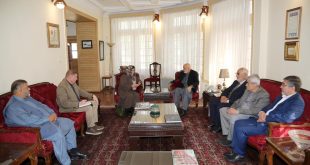By Javier Delgado Rivera
On Thursday, the United Nations (U.N.) Security Council made public a comprehensive report put together by this body’sAnalytical Support and Sanctions Monitoring Team.
This 24-page paper focuses on the most recent developments of the Islamic State in Iraq and the Levant (Da’esh), Al-Qaida and associated individuals and entities in the areas where they operate worldwide.
According to this landmark report – which intelligence is mostly provided by the own U.N. member states – the following are the main militant organizations with a presence in Afghanistan today:
─ Al-Qaida. As we speak, the armed Salafist group is “covertly active” in 12 Afghan provinces. The U.N. Monitoring Team estimates in between 400 and 600 the number of Al-Qaida fighters in Afghanistan today, as its maintains that Aiman al-Zawahiri – who took over the leadership of al-Qaeda following the killing of Osama Bin Laden – remains based in the country.

The report also notes that Al-Qaida’s leadership maintains close contacts with the Haqqani Network. “In February 2020, al-Zawahiri met with Yahya Haqqani, the primary Haqqani Network contact with Al-Qaida since mid-2009, to discuss ongoing cooperation,” reveals it.
The U.N. warns that Al-Qaida is further entrenching in regions beyond its historical stronghold in Afghanistan, “where it faces a serious challenge if the peace process develops momentum.” An example is Al-Qaida in the Indian Subcontinent (AQIS), a terrorist group that, under the Taliban umbrella, has between 150 and 200 members from Bangladesh, India, Myanmar and Pakistan in the provinces of Nimruz, Helmand and Kandahar.
─ The Islamic State in Iraq and the Levant-Khorasan (ISIL-K). The Afghan offshoot of Daesh is estimated to have around 2,200 militants in the country. In its report, the U.N. points out that ISIL has suffered severe reverses in its former Afghan strongholds of Nangarhar and Kunar provinces, while cautioning that is too soon to discount it as a threat.
Although in territorial retreat, “ISIL-K remains capable of carrying out high-profile attacks in various parts of the country, including Kabul. It also aims to attract Taliban fighters who oppose the agreement with the United States,” warns the report.
In a forewarning of notorious significance for the country, the U.N. signals that ISIL “hopes to exploit changing dynamics between the Taliban, ISIL-K and Al-Qaida in the context of the Afghan peace process.”
It is worth remembering that one of the key components of the U.S.-Taliban agreement is the commitment of the insurgent movement to suppress any al-Qaida threat in Afghanistan, and keep fighting ISIL-K.
However, ISIL-K does not seem intimidated by the pact signed in Doha, as it “is seeking to pursue ‘a global agenda’ by implementing the ISIL core’s leadership approach, which considers Afghan territory a base for spreading terrorist influence across the wider region,” argues thisU.N. Monitoring Team.
─ Tehrik-e Taliban Pakistan (TTP). According to the information facilitated by U.N. member states, the report maintains that the TTP would have today between 6,000 and 6,500 Pakistani foreign terrorist fighters in Afghanistan, “posing a threat to both countries.”
─ Eastern Turkistan Islamic Movement (ETIM). This group, founded by Uyghur jihadists in Western China, and also known as the Turkestan Islamic Party (TIP), has recently suffered significant losses in Syria. Today, as the report highlights, some of its militants and dependants are seeking to transit through Turkey and Iran to northern Afghanistan to join its affiliate here in the provinces of Badakhshan, Kunduz and Takhar. As a result, around 500 fighters of this group operate today in the Badakhshan districts of Raghistan and Warduj.

─ Islamic Movement of Uzbekistan (IMU). According to the report, the IMU has a membership of around 140 people in Afghanistan, including family members, mainly based in the Almar and Davlat Abad districts of Faryab province.
However, one of the countries (unspecified in the report) that provided information to the U.N. about this group assesses the movement’s strength in Afghanistan in around 1,500, including family members.
─ Khatiba Imam al-Bukhari (KIB). A splitter from IMU, this Uzbek jihadist organization is mainly operative in Faryab province. Active under the Taliban umbrella, the KIB also maintains close contact with its core leadership in the Syrian province of Idlib.
Anecdotally, the report notes that Abu Yusuf Muhajir, the head of this group in Syria, congratulated the Taliban on their agreement with the United States the very same day (February 29) of the signing of the peace pact describing it as “the great victory of the Islamic Ummah.”
In short
Two of the report ‘s findings are particularly concerning: 1) the high number of TTP militants in Afghan soil; and, 2) the confirmation that Al-Qaida’s maintains close contacts with the Taliban’s Haqqani Network.
Well-aware that the second assertion will not go down well in Washington, the Taliban have already dismissed theU.N. claims. In a statement issued over the weekend, Zabihullah Mujahid, the Taliban spokesman, dismissed the allegations contained in the U.N. report, describing them as ‘false information and propaganda’.
As the central driver behind the ongoing peace effort in Afghanistan, some of the findings contained in this U.N. investigation should make the White House weight a, until now absent, level of pressure to the Taliban. It is time for the armed group to not just commit, but also comply with their stated pledge to stamp out Al-Qaida from Afghan soil – and stop killing their country fellows.
_____
Javier Delgado Rivera is a New York-based freelance journalist writing about the United Nations. His articles have appeared in Carnegie Council, Huffington Post, South China Morning Post, Middle East Eye, Asia Times, and Jakarta Globe, among many others. You can see his work at his portfolio delgadorivera.com.
Prior to moving to New York, Javier lived in China, India and Brussels, where he worked as communications advisor for several think tanks and advocacy groups. Javier holds an MA in Conflict Resolution from the University of Coventry (UK). He also runs @TheUNTimes on Twitter, and you can reach out to him at [email protected]
 Afghanistan Times
Afghanistan Times



